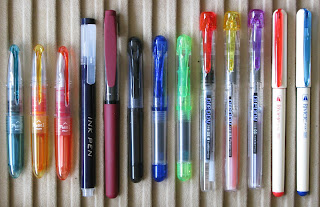Fountain pens have evolved a lot along their 150 years of history. One of the systems that has seen more changes is that related to the way the pen is filled with ink. From the dip pens with no ink deposit to the present disposable pens, a number of technical solutions have been proposed and developed. All of them, in practical terms, fit into these three categories: eyedroppers, self-fillers, cartridges.
Eyedropper pens need an external device –an eyedropper or a syringe— to fill the pen barrel with ink. This is an old system, but these pens have the great advantages of a big ink reservoir and of no technical complication.
Self-fillers, on the contrary, need of some internal deposit and of some device to pump the ink from the inkwell through the nib and feed. These systems are really varied—from piston fillers to aerometric bladders to levers acting on rubber sacs… These pens are the most technically complex in the market. Their ink deposits can be both big and small—each pen is different on this.
Nowadays, however, most newly made pens use sealed cartridges together –if the pen allowed so— with ad-hoc converters to make the pen to work as a self-filler. These pens, usually, have small ink capacity, given by the cartridge or converter, but their cartridges are small and easy to carry.
Some brands remain loyal to self-filling systems. That is the case of Pelikan, for instance. Others opt for the simplicity of cartridges and converters. That is the case of most Japanese manufacturers, although recently they have marketed a couple of self-filling models. Some of their top models, however, are eyedroppers.
 One of the few Japanese modern examples of self-filling pen. A piston-filler Katoseisakusho made in celluloid.
One of the few Japanese modern examples of self-filling pen. A piston-filler Katoseisakusho made in celluloid.
So, the final decision pertains to the collector or to the user. The convenience of the cartridge or the romantic tradition of the self-filling or eyedropper systems?
This discussion is never ending and often leads nowhere. Weight and technical complexity or ease of use and reliability? A second pen as a back up or a spare cartridge in the pocket? Romantic authenticity —whatever that might mean— or ease of use?
At the end, companies are catering the cravings of the buyer, not to mention that there exist a vast number of old pens with any technical solution. There are pens in all price ranges with either of the systems: self-fillers, cartridge only pens, cartridge and converter pens, eyedroppers… The exception, however, might be that of currently-produced eyedroppers—new eyedroppers tend to be very expensive.
It is my impression, however, that most stylophiles prefer self-filling fountain pens. Some, very ardently, following the backwardness of the fountain pen use.
As for myself, I am very eclectic on this matter. I do dislike disposable pens, although I manage to refill them. And I rather stay away from cartridge-only pens, despite I am fond of refilling cartridges with the ink of my choice.
Now, you, fellow stylophile reader, what do you prefer?
Bruno Taut
(Inagi, July 11-12 2010)
[labels: estilofilia, Pelikan, Soennecken, soluciones técnicas, Katoseisakusho, Sheaffer, conversor, Japón, Merz and Krell]




















































